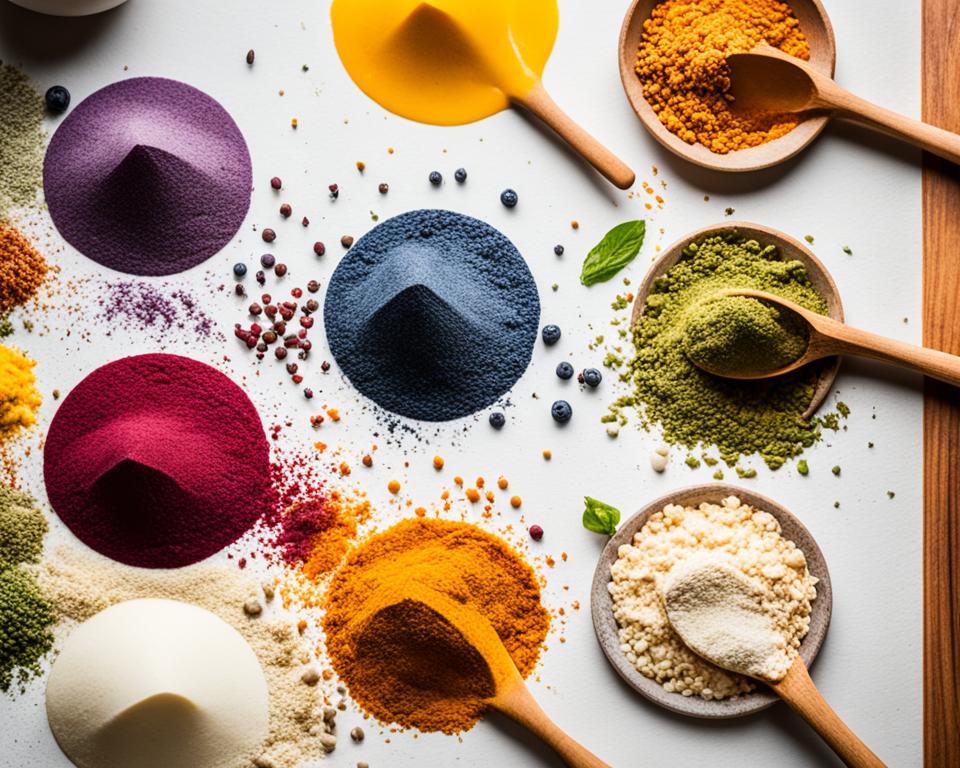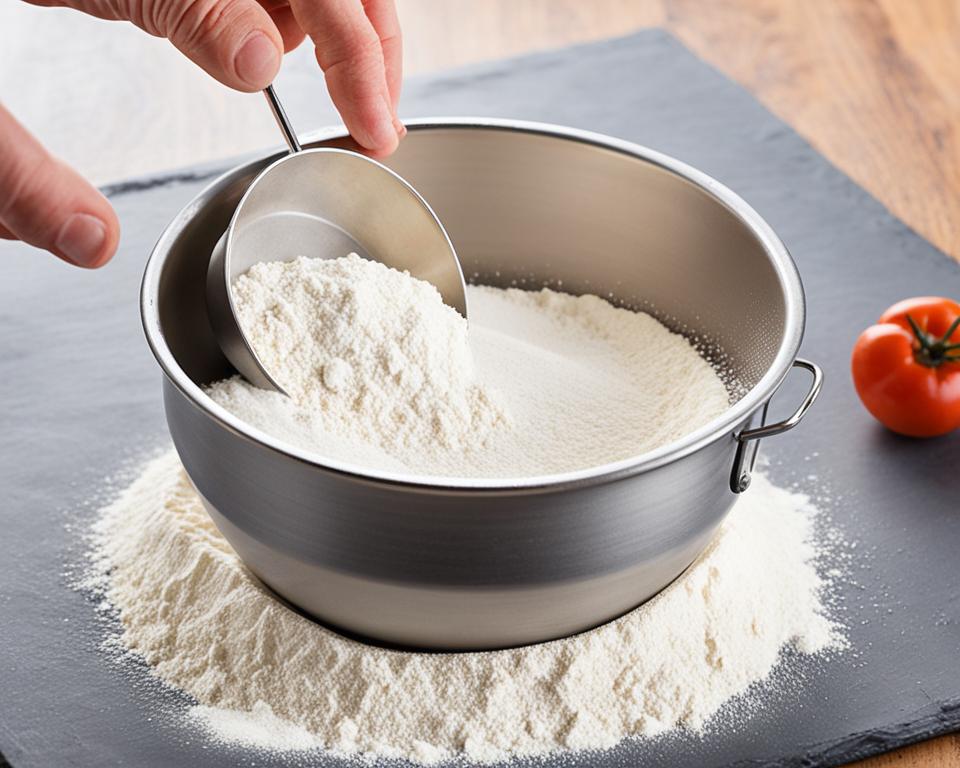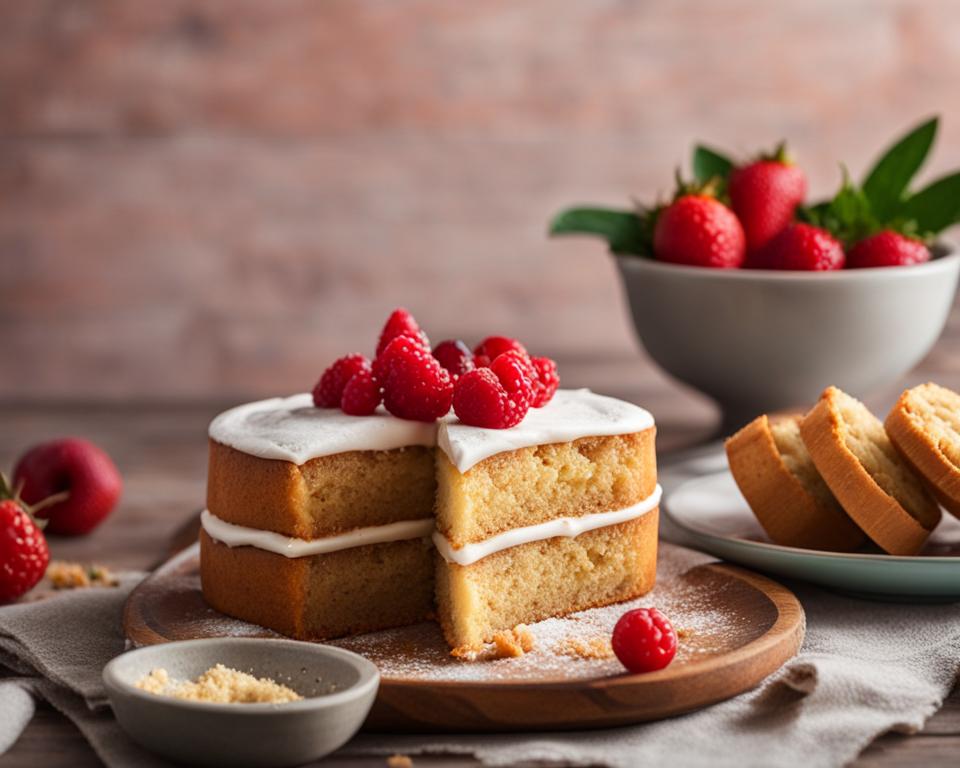Are you ready to take your baking skills to the next level? Whether you’re a beginner or an experienced baker, there are always new techniques and tricks to discover that can transform your homemade treats into culinary masterpieces. In this article, we will uncover a range of simple baking secrets, easy tips, and foolproof techniques that will help you create delicious delights every time you step into the kitchen.
Key Takeaways:
- Learn essential baking secrets and expert advice to enhance your baking skills.
- Discover quick baking tricks and hassle-free baking secrets for convenient and delicious results.
- Explore beginner-friendly baking hacks that make baking enjoyable and accessible for everyone.
- Unlock the secrets to foolproof baking techniques that guarantee success in the kitchen.
- Master must-know baking tips to achieve the perfect texture, consistency, and flavor in your baked goods.
Mastering the Art of Thickening Sauces
Thickening sauces is an essential skill that can take your culinary creations to the next level. By adding the perfect consistency and mouthfeel to your dishes, you can enhance their flavor and texture. One of the key factors in achieving the desired thickness is choosing the right thickener. Different thickeners, such as cornstarch, tapioca starch, wheat flour, and arrowroot, offer unique properties that influence the final result.
One crucial process involved in thickening sauces is gelatinization, which occurs when starch is heated with water. This process increases the viscosity of the sauce, giving it a thicker consistency. Understanding the properties of different thickeners is crucial in selecting the one that will best suit your dish.
Cornstarch is a popular and versatile thickener known for its ability to create transparent and glossy sauces. It has a neutral flavor, making it suitable for a wide range of dishes. Arrowroot powder, on the other hand, offers a neutral taste and a glossy finish, making it perfect for fruit pie fillings or sauces that contain acidic ingredients like lemon juice or tomato paste.
Potato starch and tapioca starch are excellent choices when you’re looking to add texture and maintain consistency. Potato starch provides a smooth and creamy texture, while tapioca starch offers a consistent and desirable thickness. Both starches work well in a variety of dishes, giving you the freedom to experiment and achieve the perfect result.
By understanding the properties and characteristics of different thickeners, you can choose the one that will enhance the taste and texture required by your recipes. Whether you’re looking for transparency, neutrality, texture, or consistency, each thickener has its own unique contribution to offer.
“The right thickener can transform any sauce, adding depth and richness to the flavors.” – Chef Julia Smith
Comparing Thickeners
| Thickener | Properties | Best Use |
|---|---|---|
| Cornstarch | Transparency, no flavor | Sauces, gravies |
| Tapioca Starch | Consistent thickness | Fruit pie fillings, soups |
| Wheat Flour | Thickening and flavoring | Traditional sauces |
| Arrowroot | Neutral taste, glossy finish | Fruit pie fillings, acidic sauces |
Introducing Hydrocolloid Thickeners
Hydrocolloid thickeners are culinary substances that possess the remarkable ability to enhance the texture and stability of various dishes when combined with water. These thickeners offer unique properties that elevate the overall culinary experience, and understanding their distinct features can help optimize your cooking endeavors.
Tapioca starch, renowned for its neutral taste and visually appealing glossy effect, is a popular choice for thickening sauces and perfecting the texture of baked products. Its versatility makes it an excellent addition to a wide range of recipes.
Xanthan gum, another widely used hydrocolloid thickening agent, is revered for its all-purpose stabilizing properties. Whether you’re working with sauces, dressings, or even gluten-free baking, xanthan gum can provide the perfect consistency and structure.
Pectin, commonly employed in the creation of delectable jams and jellies, offers the unique ability to achieve thickening effects while preserving the original flavor profile of these fruity delights.
By acquainting yourself with the characteristics of each hydrocolloid thickener, namely tapioca starch, xanthan gum, and pectin, you’ll be able to select the most suitable option for your specific culinary needs. Armed with this knowledge, you can unleash your creativity in the kitchen and confidently experiment with these versatile ingredients.
Enhance the texture and stability of your dishes with hydrocolloid thickeners like tapioca starch, xanthan gum, and pectin, and take your culinary creations to new heights.
The Unique Qualities of Hydrocolloid Thickeners
| Thickener | Properties |
|---|---|
| Tapioca Starch | Neutral taste, glossy effect |
| Xanthan Gum | All-purpose stabilizer |
| Pectin | Preserves original flavor in jams and jellies |
Techniques for Proper Thickening
Proper techniques are essential when it comes to effectively incorporating thickeners into your sauces and dishes. These techniques allow you to achieve the desired viscosity and consistency, ensuring excellent results every time.
Creating a Slurry for Even Distribution
One helpful technique is to create a slurry by combining a starch, such as cornstarch or arrowroot powder, with a cooled liquid before adding it to the dish. This step prevents lumps or clumps and ensures even distribution of the thickener throughout the sauce or dish. It’s as simple as whisking together the starch and liquid until it forms a smooth, pourable mixture.
Optimizing Cooking Time for Consistency
Cooking time plays a crucial role in achieving the right texture and consistency. It’s important to find the balance between undercooking and overcooking the sauce. If cooked too briefly, you may end up with a raw flour taste, while overcooking can result in a sauce that is too dense or thick. Keep an eye on the cooking process and test the consistency as you go to ensure perfect results.
Considering Cooling and Reheating Properties
Another factor to consider when using thickeners is their cooling and reheating properties. Some thickeners may not hold up well after temperature adjustments. For example, a sauce thickened with cornstarch may lose its desired consistency when cooled and reheated. Understanding how different thickeners react to temperature changes allows you to make necessary adjustments to maintain the ideal thickness and texture.
By mastering these techniques for proper thickening, you can confidently create sauces and dishes with the perfect consistency and texture. Whether you’re thickening a savory gravy or a luscious dessert sauce, these techniques will ensure your culinary creations are a success.
Continue reading to learn how to enhance the flavors of your dishes with thickeners and the importance of matching thickeners to ingredients.
Enhancing Flavor with Thickeners
Thickeners are not just essential for improving the texture of dishes, but they also play a significant role in enhancing the flavor. By binding and releasing flavor molecules over time, thickeners can take your culinary creations to a whole new level, intensifying the overall taste experience.
When incorporated properly, thickeners have the ability to concentrate and elevate other flavors present in the dish, resulting in a more complex and satisfying flavor profile. Whether you’re cooking a hearty stew, a savory sauce, or a delectable dessert, the right thickener can make a world of difference.
So how do thickeners enhance the flavor of your dishes? Let’s take a closer look:
- Concentration of Flavors: Thickeners act as vehicles for flavor, allowing them to develop and intensify as the dish cooks. As the liquid thickens, the flavors become more concentrated, creating a more pronounced and rich taste.
- Release of Flavor: Thickeners have the ability to release flavor molecules gradually, enhancing the overall taste experience. This slow release of flavor adds depth and complexity to your dishes, making every bite a delightful adventure.
- Texture Improvement: As thickeners work their magic, they also contribute to improving the texture of your dishes. Whether it’s adding creaminess to sauces or creating a smooth and velvety consistency in desserts, thickeners play a crucial role in achieving the perfect mouthfeel.
By selecting the right thickener for your dish and pairing it with compatible ingredients, you can create unforgettable culinary masterpieces that burst with flavor. So unleash your creativity in the kitchen and let the magic of thickeners enhance the taste of your favorite recipes!
Matching Thickeners to Ingredients
Choosing the right thickener for your dish is crucial in achieving a harmonious blend of flavors and textures. Different thickeners have distinct properties that make them more suitable for specific ingredients and culinary creations. One versatile thickener that works well with tart food items is arrowroot powder.
Arrowroot powder is a gluten-free option known for its appealing glimmer and neutral taste. It is an ideal choice for thickening fruit pies or sauces that contain tart ingredients like lemon juice or tomato paste. Unlike cornstarch, which may not perform well with acidic elements, arrowroot retains its thickening capacity even in the presence of tart flavors, maintaining the desired consistency without compromising the overall taste.
When matching thickeners to ingredients, it’s also important to consider the level of acidity in your dish. The acidity of certain ingredients can affect the performance of thickeners, potentially altering the desired texture and flavor. By selecting the appropriate thickening agent that can withstand the acidity, you can ensure a consistent and savory outcome.
“Matching thickeners to ingredients ensures the desired consistency and savoriness in every meal.”
| Ingredient Type | Recommended Thickener |
|---|---|
| Tart food items (e.g., lemon, tomato) | Arrowroot powder |
| Highly acidic ingredients | Arrowroot powder |
| General thickening purposes | Other suitable options: cornstarch, tapioca starch, potato starch |
By carefully matching thickeners to your specific ingredients, you can create well-balanced dishes that offer a satisfying consistency and savoriness. Experimenting with different thickeners allows you to unlock new culinary possibilities and elevate your cooking to the next level.
Creating Depth of Flavor
When it comes to cooking with thickeners, it’s not just about knowing their components. It’s also about understanding how they interact with other ingredients and the cooking process to create dishes with depth of flavor and mouthwatering textures. By combining the right thickener with the perfect cooking technique and carefully chosen ingredients, you can elevate your dishes to new heights of culinary delight.
One technique that can enhance the flavor of your dishes is reducing a sauce through simmering. As the sauce reduces, the flavors intensify and become more concentrated. This deepening of flavors creates a rich and satisfying taste experience that can’t be replicated through any other method.
“Reducing a sauce through simmering deepens flavors and creates mouthwatering textures due to the concentration of essential elements.”
Thickeners also have the ability to bind and release flavor molecules over time, enhancing the overall taste of your dishes. This interaction between thickeners and other ingredients contributes to the complexity and richness of flavors, making each bite a delight to the senses.
By refining your techniques in utilizing thickeners, you can unlock the full potential of your ingredients and create dishes that truly wow. Experiment with different combinations and explore how thickening agents interact with various flavors to create unique and unforgettable culinary experiences.
Tips for Creating Flavorful Dishes:
- Choose the right thickener for your dish based on its compatibility with the other ingredients.
- Experiment with reducing sauces to intensify flavors and create mouthwatering textures.
- Consider how thickeners interact with other components in your recipe to create a harmonious flavor profile.
- Refine your techniques in utilizing thickeners to bring out the best in your ingredients.
With these tips and a little culinary creativity, you can take your dishes to new heights of flavor and create unforgettable dining experiences.

Tips and Tricks for Perfect Consistency
Achieving the ideal consistency in your cooking creations requires careful consideration of various factors. From starch selection to cooling and reheating adjustments, every step plays a role in achieving the perfect thickness and texture in your dishes.
Choosing the Right Starch
When it comes to achieving the desired consistency, selecting the appropriate starch is key. Different thickeners have unique properties that can affect the final result of your dish. Consider factors such as transparency, taste, texture, and consistency when choosing a starch for your recipe.
For example, cornstarch is a popular choice for its transparency and neutral flavor. Arrowroot powder, on the other hand, offers a glossy finish and is especially suitable for fruit pie fillings or sauces with tart ingredients. Potato starch and tapioca starch are known for their textural benefits and can help maintain the desired consistency in various recipes.
By understanding the properties of different thickeners and their effects on your dishes, you can make informed decisions when selecting the perfect starch for achieving the desired consistency.
Cooling and Reheating Adjustments
It’s important to note that different thickeners behave differently when cooled or reheated. Some thickeners may lose their thickening properties or change in consistency when exposed to temperature adjustments.
Consider the cooling and reheating processes involved in your recipe and make adjustments accordingly. If your dish needs to be refrigerated and then reheated, choose a thickener that can withstand these temperature changes without compromising the desired consistency.
Experiment with different thickeners and observe how they behave when cooled and reheated. This knowledge will allow you to make necessary adjustments throughout the culinary process to maintain the perfect thickness and texture in your dishes.
Starch Comparison for Consistency
| Starch | Properties | Suitable For |
|---|---|---|
| Cornstarch | Transparent, neutral flavor | Sauces, gravies, fruit fillings |
| Arrowroot Powder | Glossy finish, neutral taste | Fruit pie fillings, sauces with tart ingredients |
| Potato Starch | Textural benefits, maintains consistency | Baked goods, stews, soups |
| Tapioca Starch | Consistency, texture enhancement | Puddings, pies, fruit fillings |
Understanding the properties of different thickeners and how they can affect the consistency of your dishes is key to achieving the perfect thickness. By selecting the right starch, making cooling and reheating adjustments, and mastering the art of consistency, you can take your culinary creations to new heights.
Avoiding Lumps and Clumps
Lumps and clumps can be a source of frustration when making sauces or stews. To prevent lump formation, it’s important to mix the thickener with cold liquid to form a slurry before adding it to the hot dish. Mixing technique is crucial in achieving a smooth texture throughout the dish. By gradually adding the slurry while constantly stirring, you ensure even distribution and lump prevention.
Constant stirring allows the thickener to dissolve and incorporate seamlessly into the sauce or stew. It also helps to prevent the formation of undesirable clumps. Stirring should continue for a few minutes after adding the thickener to allow it to fully thicken and eliminate any remaining lumps. This technique ensures a consistent and velvety texture in your dishes.
By following these simple steps, you can achieve perfectly smooth results every time you cook. Say goodbye to lumps and clumps and enjoy flawlessly thickened sauces and stews!

Quote:
“Mixing technique and constant stirring are essential in achieving lump-free sauces and stews.” – Chef Julia Blake
Tips for Avoiding Lumps and Clumps:
- Mix the thickener with cold liquid to form a slurry before adding it to the hot dish.
- Gradually add the slurry while constantly stirring to ensure even distribution and prevent lump formation.
- Continue stirring the dish for a few minutes after adding the thickener to fully dissolve and thicken it.
| Mixing Technique | Constant Stirring | Lump Prevention |
|---|---|---|
| Ensures even distribution | Dissolves thickener completely | Prevents clump formation |
| Achieves smooth texture | Eliminates lumps | Consistent results |
Adjusting Thickness on the Fly
In the world of cooking, achieving the perfect consistency is crucial for a truly satisfying dish. Sometimes, you may find that your sauce or stew is too thin or too thick. But don’t worry, there are simple techniques that can help you adjust the thickness on the fly and save your culinary creation.
If a sauce or stew is too thin and lacking the desired richness, you can easily thicken it by adding an appropriate amount of thickener. Choose a thickener that complements the flavors of your dish and gradually incorporate it while stirring continuously. This allows the thickener to blend in smoothly and evenly, avoiding the formation of lumps or clumps.
On the other hand, if your dish turns out thicker than expected, you can adjust the consistency by incorporating a small amount of liquid. Add the liquid bit by bit, whether it’s water, broth, or another suitable liquid, while whisking continuously. This gradual addition and constant whisking ensure that the liquid is incorporated evenly, preventing any lumps or uneven distribution of the added liquid.
By having the ability to adjust and fine-tune the thickness of your sauces and stews during the cooking process, you can achieve more enjoyable and customizable results. Whether you prefer a thick and hearty sauce or a lighter consistency, these techniques allow you to tailor your dishes to your exact preferences.
Quick Tips for Adjusting Thickness:
- Choose the right thickener that matches your dish’s flavors and desired consistency.
- Add the thickener gradually while stirring continuously to avoid lumps or clumps.
- If your dish is too thin, add an appropriate amount of thickener.
- If your dish is too thick, incorporate a small amount of liquid bit by bit while whisking continuously.
With these simple techniques, you’ll have full control over the thickness of your sauces and stews, ensuring a delightful dining experience every time.
| Too Thin | Just Right | Too Thick |
|---|---|---|
| Sauce lacks body and richness | Perfectly balanced consistency | Dish feels heavy and overpowering |
| Fluid consistency that doesn’t cling to ingredients | Visually pleasing thickness that coats ingredients evenly | Gummy texture that doesn’t blend well with other components |
| Rapidly absorbs into other ingredients | Drizzles and holds its shape when poured | Creates a dense layer that overwhelms other flavors |
Conclusion
Unlocking simple baking secrets is the key to creating delicious homemade treats. Whether you’re a beginner or an experienced baker, incorporating these easy baking tips, quick baking tricks, and foolproof baking techniques will elevate your skills to new heights. By utilizing essential baking secrets and expert baking advice, you can achieve consistent results that will impress your friends and family.
Experimentation is the cornerstone of baking, and with a little creativity, you can take your baked goods to the next level. From using thickeners to enhance texture and flavor to incorporating Hershey’s products in your recipes, there are endless possibilities to explore. Remember, the secret to success lies in understanding the techniques and being willing to try new things.
So let these hassle-free baking secrets be your guide as you unleash your creativity in the kitchen. With a dash of inspiration and a sprinkle of know-how, you’ll wow your loved ones with delicious and beautifully crafted treats. Keep these must-know baking tips and top baking tricks in mind, and watch as your homemade creations become the talk of the town.
FAQ
What are some simple baking secrets?
Simple baking secrets include using quality ingredients, measuring accurately, preheating the oven, and following the recipe instructions carefully.
What are some easy baking tips for beginners?
Easy baking tips for beginners include starting with simple recipes, using the right tools, experimenting with flavors, and practicing basic techniques.
Are there any quick baking tricks to save time?
Yes, quick baking tricks include using pre-made ingredients, planning ahead, multitasking, and utilizing time-saving kitchen appliances.
Are there foolproof baking techniques for successful results?
Yes, foolproof baking techniques include properly creaming butter and sugar, properly measuring ingredients, and testing for doneness with toothpicks.
What are some beginner-friendly baking hacks?
Beginner-friendly baking hacks include using boxed mixes, substituting ingredients, using parchment paper for easy cleanup, and learning from baking blogs and tutorials.
What are some essential baking secrets to know?
Essential baking secrets include understanding oven temperatures, knowing how to properly frost cakes, using the correct mixing techniques, and having patience.
Can you provide expert baking advice for advanced bakers?
Expert baking advice for advanced bakers includes experimenting with flavors, creating your own recipes, knowing how to troubleshoot baking issues, and mastering advanced techniques.
What are some must-know baking tips for success?
Must-know baking tips for success include preheating the oven, properly greasing pans, allowing ingredients to come to room temperature, and using an oven thermometer for accuracy.
Are there hassle-free baking secrets for stress-free baking?
Yes, hassle-free baking secrets include organizing your ingredients and tools before starting, cleaning as you go, and understanding the recipe before beginning.
Can you share some top baking tricks?
Top baking tricks include using a kitchen scale for precise measurements, incorporating flavors through infusions and extracts, and using a piping bag for professional-looking decorations.
How can thickeners be used in baking?
Thickeners can be used in baking to achieve the perfect texture and consistency in baked goods like fruit pie fillings or gluten-free treats.




